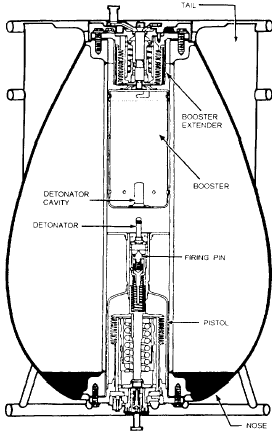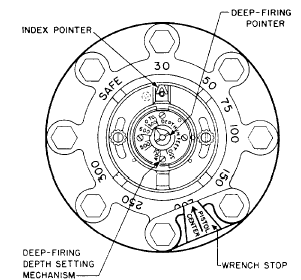|
USES OF HYDROSTATIC PRESSURE Various shipboard operations depend on the use of
hydrostatic pressure. For example, in handling depth
charges, torpedoes, mines, and some types of aerial
bombs, youll be dealing with devices that operate by
hydrostatic pressure. In addition, youll deal with
hydrostatic pressure in operations involving divers.
Firing Depth Charges
Hiding below the surface exposes the submarine to
great fluid pressure. However, it also gives the sub a
great advantage because it is hard to hit and, therefore,
hard to kill. A depth charge must explode within 30 to
50 feet of a submarine to cause damage. That means the
depth charge must not go off until it has had time to sink
to approximately the same level as the sub. Therefore,
you use a firing mechanism that is set off by the pressure
at the estimated depth of the submarine.
Figure 10-1 shows a depth charge and its interior
components. A depth charge is a sheet-metal container
filled with a high explosive and a firing device. A tube
passes through its center from end to end. Fitted in one
end of this tube is the booster, a load of granular TNT
that sets off the main charge. It is also fitted with a safety
fork and an inlet valve cover. Upon launching, the safety
fork is knocked off, and the valve cover is removed to
allow water to enter.
When the depth charge gets about 12 to 15 feet
below the surface, the water pressure is sufficient to
extend a bellows in the booster extender. The bellows

Figure 10-1.-A depth charge.
trips a release mechanism, and a spring pushes the
booster up against the centering flange. Notice that the
detonator fits into a pocket in the booster. Unless the
detonator is in this pocket, it cannot set off the booster
charge.
Nothing further happens until the detonator fires. As
you can see, the detonator fits into the end of the pistol,
with the firing pin aimed at the detonator base. The pistol
also contains a bellows into which the water rushes as
the charge goes down. As the pressure increases, the
bellows begins to expand against the depth spring. You
can adjust this spring so that the bellows will have to
exert a predetermined force to compress it.
Figure 10-2 shows you the depth-setting dials of one
type of depth charge. Since the pressure on the bellows
depends directly on the depth, you can select any depth
on the dial at which you wish the charge to go off. When
the pressure in the bellows becomes sufficiently great,
it releases the firing spring, which drives the firing pin

Figure 10-2.-Depth-setting dial.
into the detonator. The booster, already in position, then
fires and, in turn, sets off the entire load of TNT.
These two bellowsoperated by hydrostatic
pressureserve two purposes. First, they permit the
depth charge to fire at the proper depth; second, they
make the charge safe to handle and carry. If you should
accidentally knock the safety fork and the valve inlet
cover off on deck, nothing would happen. Even if the
detonator should go off while you were handling the
charge, the main charge would not fire unless the booster
was in the extended position.
|

